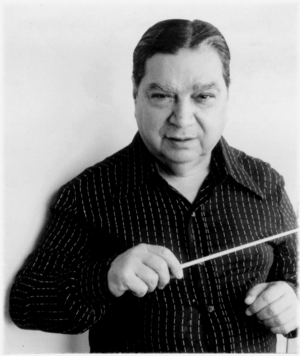César Guerra-Peixe facts for kids
Quick facts for kids
César Guerra-Peixe
|
|
|---|---|
 |
|
| Born |
César Guerra-Peixe
18 March 1914 Petrópolis, Rio de Janeiro, Brazil
|
| Died | 26 November 1993 (aged 79) |
| Occupation |
|
César Guerra-Peixe (born March 18, 1914 – died November 26, 1993) was a talented musician from Brazil. He was a violinist, a composer who wrote music, and a conductor who led orchestras.
He was born in Petrópolis, a city in Brazil. His parents were immigrants from Portugal. Throughout his life, Guerra-Peixe worked in many musical roles. He played in orchestras and wrote music for radio shows. He also composed for recordings, movies, and cultural documentaries. You can hear his music in many Brazilian films. Some of these include Terra é Sempre Terra and O Canto do Mar.
Contents
Exploring Brazilian Music
César Guerra-Peixe was very interested in Brazilian culture. He especially loved traditional music from northeastern Brazil. He mixed these Brazilian sounds into his own compositions. He also studied new ways of composing music.
Researching Folk Music
While living in Recife, he did special research. He went out and studied traditional Brazilian music and culture. This kind of study is called field work. He wrote many articles about his findings. These articles were published in a magazine called Revista Brasileira de Folclore. He spent his life researching and sharing Brazilian culture. He is well known for these important contributions.
Writing About Maracatu
As an ethnomusicologist, he studied music from different cultures. He wrote an important book called Os Maracatus do Recife. This book was about maracatu, a traditional Brazilian rhythm and dance. The first edition came out in 1955, and a second one in 1980.
His Famous Violin Music
One of his well-known pieces is the Concertino for Violin and Orchestra. A concertino is like a small concerto. It features a solo instrument with an orchestra.
The Rabeca's Influence
This piece for violin was inspired by the sound of the rabeca. The rabeca is a type of Brazilian folk fiddle. In northeastern Brazil, people use the rabeca for many things. It helps them play for traditional dances and street plays.
Blending Old and New Sounds
Guerra-Peixe used the rabeca's sounds in his classical violin piece. He showed off all the violin's technical abilities. At the same time, he included the rhythms and melodies of the rabeca. This created an orchestral sound that reminded listeners of traditional Brazilian music.
His Recorded Works
César Guerra-Peixe recorded many musical pieces. These recordings helped share his music with more people. His works include various types of music. Some were released on records and later on CDs.

